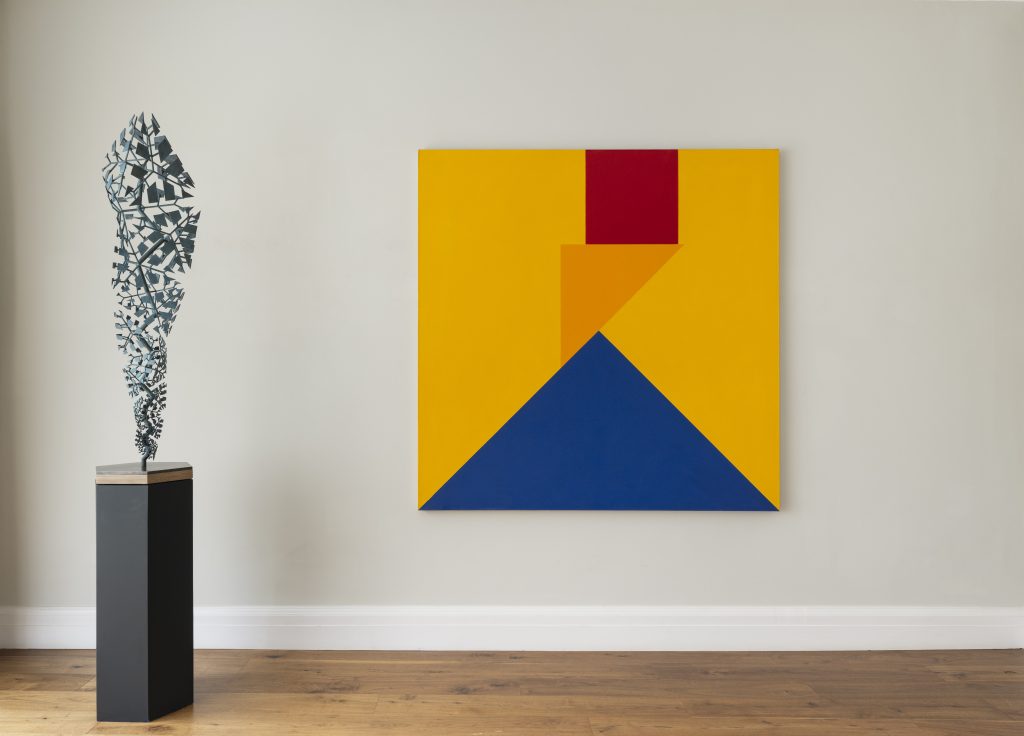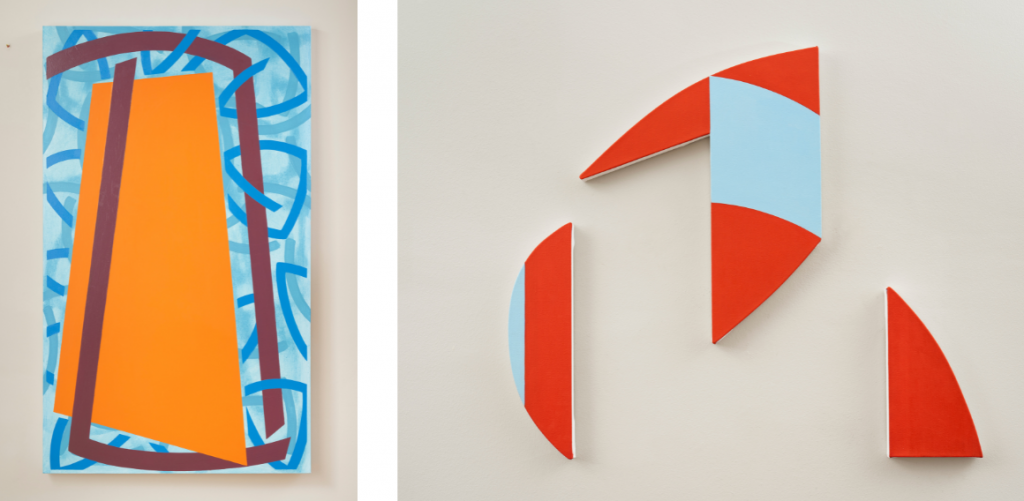Fracture: Huxley, Jackson, Shawcross, Robertson
Artvisor presents Fracture. Huxley, Jackson, Shawcross, Robertson — an intergenerational survey featuring four renowned British abstractionists curated by Piero Tomassoni. Spanning both painting and sculpture, these artists are connected through their shared association with the Royal Academy, each bringing their distinctive perspective to abstract art.

Installation View of Fracture. Paul Huxley, Untitled (King) (1969) and Conrad Shawcross, Fracture (R14C30), (2021). © Damian Griffith
This exhibition anchors itself in the mid-20th century, a pivotal moment when the European movements of Constructivism and De Stijl converged, embracing precise shapes, mathematical systems, and integrated architectural compositions in visual means.
Huxley’s Untitled No. 1-200 series from the 1960s exemplifies what structuralist Roland Barthes described as a “syntagm”—an arrangement and juxtaposition of elements that creates a complete proposition. In essence, Huxley builds objective sentences in form. Known for his precise geometric arrangements, Huxley’s work harmonises the interplay of shape, balance, and space, hovering between angst, amusement, and colourist nuance.
Conversely, his younger contemporary, once pupil and now fellow Royal Academician, Vanessa Jackson, synthesises these structuralist elements into a dynamic 3D system that is both whole, multi-dimensional, and quixotic. Her paintings examine form’s optical and psychological effects, allowing for new fundamental combinations on the picture plane.

Installation View of Fracture. Left: Vanessa Jackson, Walk Out (2008) Right: John Robertson, Catapult (2023) © Damian Griffith
Conrad Shawcross expands upon this philosophy, merging an essential cubist tradition with a postmodern sensibility. In exploring natural and molecular forms, Shawcross creates expansive works that reflect the geometric undercurrents of nature. His kinetic sculptures ask viewers to consider the forces of physics that shape the mechanics of observation and motion. His work transposes this philosophy into a near-scientific method.
The youngest artist presented, John Robertson, engages with this history of 20th-century modernism to present a structuralist hybrid between painting and sculpture. By acknowledging the non-representational crisis of postmodernism, Robertson revitalises the core tenets of De Stijl—abstraction, universalism, and spatial deconstruction. Robertson’s illusionistic and literal three-dimensionality in constituent parts embodies the climax and continuation of Huxley, Jackson, and Shawcross’s legacies.
Together, these artists carry forward a rich tradition of methodical deconstruction, both fracturing and defining a new wave of geometric abstraction that resonates into the 21st century and beyond.
Paul Huxley RA
Paul Huxley (b. 1938, UK) is renowned for his large-scale abstract paintings, which create captivating spatial compositions. His works often feature blocks of colour that appear to push against one another, contrasting neutral tones with luminous pigments. This interplay of colours invites viewers to engage with the themes of balance and fragility, as the shapes within his compositions seem precariously stacked, achievable only through the medium of canvas. Drawing inspiration from theatre and performance, Huxley’s work evokes a sense of tension, prompting the viewer to question whether the forms are on the verge of collapse or have achieved a state of perfect equilibrium.
Vanessa Jackson RA
Vanessa Jackson (b.1953, UK) has been one of London’s leading tutors of fine art, having taught at the Royal Academy Schools from 1998 to 2013, the Royal College of Art from 1993 to 2007 and the Winchester School of Art from 1979 to 1997 where she was made Head of Painting in 1988. A prominent figure on the British art scene since the 1970s, her geometric paintings play with space, architecture, and visual perception. Jackson’s use of semi-hard-edged shapes and colours intertwines the historical tradition of abstract painting as a canonical genre with optical and spatial illusions.
Conrad Shawcross RA
Conrad Shawcross (b. 1977, UK) is a contemporary British sculptor renowned for his captivating mechanical sculptures that delve into the intersections of science, philosophy, and geometry. Inspired by outdated theories and the pursuit of knowledge, Shawcross crafts intricate structures and machines. His works, often built on a monumental scale, use repetition, light, and shadow to question our perception of reality. His artistic practice merges meticulous craftsmanship with conceptual explorations. Shawcross’s sculptures transform industrial materials into mesmerising displays of pattern and motion that seem both rigidly logical and imbued with a sense of wonder.
John Robertson
John Robertson (b.1983, UK) is currently developing a body of work that explores the evolution of pictorial space, drawing heavily from art history while incorporating a distinctly contemporary perspective. At first glance, his paintings may evoke the aesthetic of late Modernist abstraction, yet they are rooted in a much earlier artistic tradition. His primary inspiration comes from two specific fifteenth-century Annunciation paintings: Fra Angelico’s Annunciation in cell three of the San Marco Monastery in Florence and the upper panel of Piero della Francesca’s Polyptych of St. Anthony, found in the National Gallery of Umbria, Perugia. Recent exhibitions of John’s work include Annunciations at Sandy Smith Studio in New York, Ex Roma V at A.P.T Gallery in London, and All or Nothing at Lungley Gallery in London. These shows continue his deep dive into the complexities of spatial perception, rooted in art history but deeply engaged with modern visual experience.
Exhibition Information
Fracture: Huxley, Jackson, Shawcross, Robertson
Curated by Piero Tomassoni
Opening on 7 October 2024
Artvisor, Mayfair, London
View by Appointment
info@artvisor.com